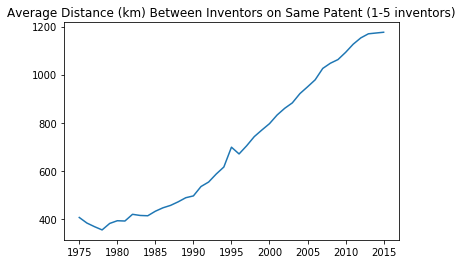Remote collaboration in innovation is on the rise. The average distance between all the inventors listed on a patent has tripled between 1975 and 2015. #ThursdayThreads
Of course, the number of inventors on a patent has also risen. But we see the same thing if we restrict attention to patents with just two inventors. More of these 2-inventor patents belong to distant collaborators.
(Though note the share of 100-500km distant patents has dropped - I don't know why) (All data pulled from patentsview and sorted by patent application year) https://www.patentsview.org/web/#viz/locations
What’s going on? Probably the internet.
To measure the impact of internet access, Forman and Zeebroeck (2012) reach back a long way, to the 1992-1998 era, when internet access was first beginning to roll across America. https://pubsonline.informs.org/doi/10.1287/mnsc.1110.1505
To measure the impact of internet access, Forman and Zeebroeck (2012) reach back a long way, to the 1992-1998 era, when internet access was first beginning to roll across America. https://pubsonline.informs.org/doi/10.1287/mnsc.1110.1505
FZ12 show that after two establishments are connected to the internet, inventors in the connected establishments are more likely to be jointly listed on patents.
Getting internet access doesn’t seem to have any impact on the number of solo-inventor or geographically clustered inventor team patents, which suggests the internet’s main advantage was in facilitating collaboration, not merely in increasing access to knowledge.
But it does that too. Studying the same era, Forman and Zeebroeck (2019) show that when two establishments are connected to the internet, patents by inventors from one establishment are more likely to cite patents by inventors from the other. https://www.sciencedirect.com/science/article/abs/pii/S0048733318302592
What’s the upshot? Forman, Goldfarb, and Greenstein (2014) show the internet helps reduce the trend towards geographic concentration of innovative activity. https://www.nber.org/papers/w20036
FGG compare the growth of county-patenting over 2000-2005 to patent levels over 1990-1995. Overall, they see a significant increase in the concentration of inventive activity: the counties with the most patents over 1990-1995 also had the fastest growth of patents over 2000-2005.
BUT - they also show this effect is reduced by greater internet access. If two counties each have low internet adoption in 1990s, the innovation gap between them grew much more quickly than for 2 counties with high levels of internet access.
What’s more, the difference between high-internet adopting and low-internet adopting counties is largest when we restrict attention to patents featuring distant collaboration among inventors.
Now; we know from elsewhere that collaboration is increasingly important for innovation. https://twitter.com/mattsclancy/status/1202673912133275648?s=20
One interpretation of these results therefore is that people living in innovative counties in the 1990s didn’t really need the internet to find potential collaborators, so it’s presence or absence didn’t matter that much.
But people living in less innovative regions benefited a lot from internet access, because it allowed them to find good collaborators and participate in the innovation economy.
Taken together - one reason for the decline in local knowledge spillovers might be the rise of the internet. https://twitter.com/mattsclancy/status/1207640469649408001?s=20
(Better transportation links might also have helped) /fin https://twitter.com/mattsclancy/status/1210237743311151104?s=20
PS - if you liked this, I write a newsletter on research on the economics of innovation, which I then turn into threads. Search my feed for #ThursdayThreads for older ones. Or subscribe to the newsletter ( https://mattsclancy.substack.com ) or RSS feed ( https://mattsclancy.substack.com/feed )
This thread is part of a larger thread of threads on remote work. https://twitter.com/mattsclancy/status/1272868025541242881?s=20

 Read on Twitter
Read on Twitter




